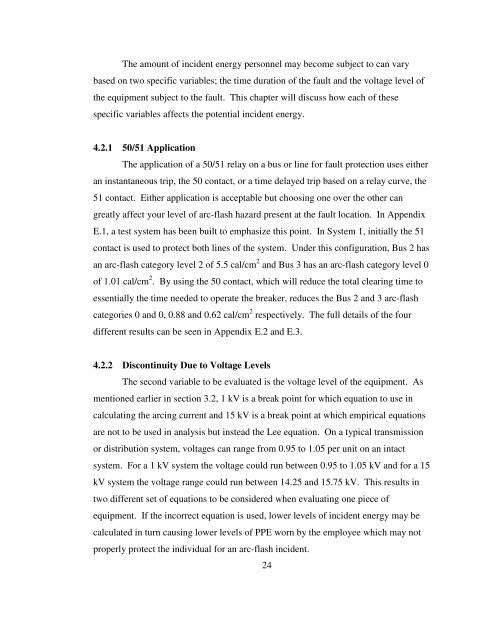arc-flash analysis of utility power systems - Michigan Technological ...
arc-flash analysis of utility power systems - Michigan Technological ...
arc-flash analysis of utility power systems - Michigan Technological ...
Create successful ePaper yourself
Turn your PDF publications into a flip-book with our unique Google optimized e-Paper software.
The amount <strong>of</strong> incident energy personnel may become subject to can vary<br />
based on two specific variables; the time duration <strong>of</strong> the fault and the voltage level <strong>of</strong><br />
the equipment subject to the fault. This chapter will discuss how each <strong>of</strong> these<br />
specific variables affects the potential incident energy.<br />
4.2.1 50/51 Application<br />
The application <strong>of</strong> a 50/51 relay on a bus or line for fault protection uses either<br />
an instantaneous trip, the 50 contact, or a time delayed trip based on a relay curve, the<br />
51 contact. Either application is acceptable but choosing one over the other can<br />
greatly affect your level <strong>of</strong> <strong>arc</strong>-<strong>flash</strong> hazard present at the fault location. In Appendix<br />
E.1, a test system has been built to emphasize this point. In System 1, initially the 51<br />
contact is used to protect both lines <strong>of</strong> the system. Under this configuration, Bus 2 has<br />
an <strong>arc</strong>-<strong>flash</strong> category level 2 <strong>of</strong> 5.5 cal/cm 2 and Bus 3 has an <strong>arc</strong>-<strong>flash</strong> category level 0<br />
<strong>of</strong> 1.01 cal/cm 2 . By using the 50 contact, which will reduce the total clearing time to<br />
essentially the time needed to operate the breaker, reduces the Bus 2 and 3 <strong>arc</strong>-<strong>flash</strong><br />
categories 0 and 0, 0.88 and 0.62 cal/cm 2 respectively. The full details <strong>of</strong> the four<br />
different results can be seen in Appendix E.2 and E.3.<br />
4.2.2 Discontinuity Due to Voltage Levels<br />
The second variable to be evaluated is the voltage level <strong>of</strong> the equipment. As<br />
mentioned earlier in section 3.2, 1 kV is a break point for which equation to use in<br />
calculating the <strong>arc</strong>ing current and 15 kV is a break point at which empirical equations<br />
are not to be used in <strong>analysis</strong> but instead the Lee equation. On a typical transmission<br />
or distribution system, voltages can range from 0.95 to 1.05 per unit on an intact<br />
system. For a 1 kV system the voltage could run between 0.95 to 1.05 kV and for a 15<br />
kV system the voltage range could run between 14.25 and 15.75 kV. This results in<br />
two different set <strong>of</strong> equations to be considered when evaluating one piece <strong>of</strong><br />
equipment. If the incorrect equation is used, lower levels <strong>of</strong> incident energy may be<br />
calculated in turn causing lower levels <strong>of</strong> PPE worn by the employee which may not<br />
properly protect the individual for an <strong>arc</strong>-<strong>flash</strong> incident.<br />
24
















